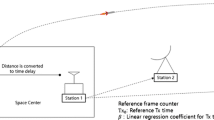Abstract
During the launch mission of a launch vehicle (LV), localization of the LV is very important for ensuring flight safety. Usually, active localization systems such as the ground tracking radar systems and onboard navigation systems of the LV are responsible for acquiring the relevant location information for localization. However, if, in addition to the existing localization methods, passive localization using ground telemetry stations can be implemented, the reliability of the flight safety control for the LV can be improved. Time of arrival (TOA), time difference of arrival (TDOA), and angle of arrival (AOA) are typical localization techniques used for an emitting target. In this paper, we examine passive TDOA/AOA localization that uses two ground telemetry stations, and propose a technique to improve its localization accuracy, based on second-order polynomial regression and the removal of the estimated multipath delays in the TDOA/AOA results. By comparing the results of our proposed technique with the measured data from an on-board GPS used in the 3rd Korea Space Launch Vehicle-1 (KSLV-1) mission, our study confirms that the localization accuracy has been improved.










Similar content being viewed by others
References
Ma, C., Klukas, R., & Lachapelle, G. (2003). An enhanced two-step least squared approach for TDOA/AOA wireless location. In Proceedings of IEEE international conference (Vol. 2, pp. 987–991).
Parkinson, B. B. W., Spilker, J. J., Axelrad, P., & Enge, P. (2010). Global positioning system: Theory and applications. In Progress in astronautics and aeronautics (Vol. 2). American Institute of Aeronautics and Astronautics.
Kwon, S., Kim, D., Lee, J., Moon, S., Chu, M., Bae, S., et al. (2018). 3D localization for launch vehicle using virtual TOA and AOA of ground stations. Wireless Personal Communications, 102(1), 507–526.
Kwon, S., Kim, D., Lee, J., Moon, S., Chu, M., Bae, S., et al. (2018). Performance analysis of 3D localization for a launch vehicle using TOA, AOA, and TDOA. Wireless Personal Communications, 103(2), 1443–1464.
Song, H.-R. (2015). Performance enhancement of launch vehicle tracking using GPS-based multiple radar bias estimation and sensor fusion. Journal of the Korea Industrial Information Systems Research, 20(6), 47–56.
Giacometti, R., Baussard, A., Jahan, D., Cornu, C., Khenchaf, A., & Quellec, J. (2016). Localization of radar emitters from a single sensor using multipath and TDOA-AOA measurements in a naval context. In 24th European signal processing conference (pp. 692–696).
Wong, S., Jassemi-Zargani, R., Brookes, D., & Kim, B. (2017). Passive target localization using a geometric approach to the time-difference-of-arrival method. Ottawa: Defence Research and Development Canada.
Dai, T., Xie, N., Feng, L., & Wang, Y. (2016). Research on the realization of passive TDOA in PCM/FM system. In European telemetry and test conference (pp. 47–50).
Steffes, C., & Rau, S. (2012). Multipath detection in TDOA localization scenarios. In Workshop on sensor data fusion: Trends, solutions, applications (SDF) (pp. 88–92).
Report ITU-R SM.2211-2. (2018). Comparison of time-difference-of-arrival and angle of arrival methods of signal geolocation.
El Gemayel, N., Jakel, H., & Jondral, F. K. (2015). A weighted least squares algorithm for passive localization in multipath scenarios. In IEEE 82nd vehicular technology conference (pp. 1–5).
Chan, Y. T., & Ho, K. C. (1994). A simple and efficient estimator for hyperbolic location. IEEE Transactions on Signal Processing, 42(8), 1905–1915.
Ho, K. S., Ik, L. S., Hyun, K. D., Yul, O. C., & Keun, L. H. (2011). A real time estimation of the target direction at mobile telemetry station by using time-delayed target designation data. In Proceedings of symposium of the Korean institute of communications and information sciences (pp. 430–431).
Boyd, S., & Vandenberghe, L. (2009). Convex optimization. Cambridge: Cambridge University Press.
Acknowledgements
This research was supported by the Space Center Development Project (II) of the Korea Aerospace Research Institute (KARI). This research was also supported by the Ministry of Science and ICT (MSIT), Korea, under the Information Technology Research Center (ITRC) support program (IITP-2020-2016-0-00314) supervised by the Institute for Information & communications Technology Planning & Evaluation (IITP). Finally, this work was supported by the National Research Foundation of Korea (NRF) Grant funded by the Korea government (MSIT: Ministry of Science and ICT) (2018R1A2B6002255).
Author information
Authors and Affiliations
Corresponding author
Additional information
Publisher's Note
Springer Nature remains neutral with regard to jurisdictional claims in published maps and institutional affiliations.
Rights and permissions
About this article
Cite this article
Kwon, S., Choi, Y., Moon, S. et al. Performance Enhancement of Hybrid TDOA/AOA Using Multipath Delay Estimation. Wireless Pers Commun 115, 2551–2568 (2020). https://doi.org/10.1007/s11277-020-07696-2
Published:
Issue Date:
DOI: https://doi.org/10.1007/s11277-020-07696-2




